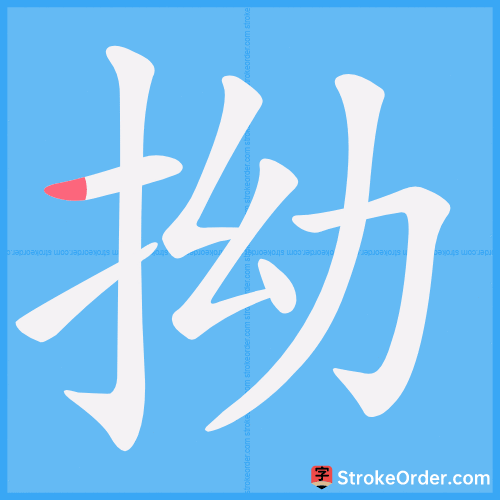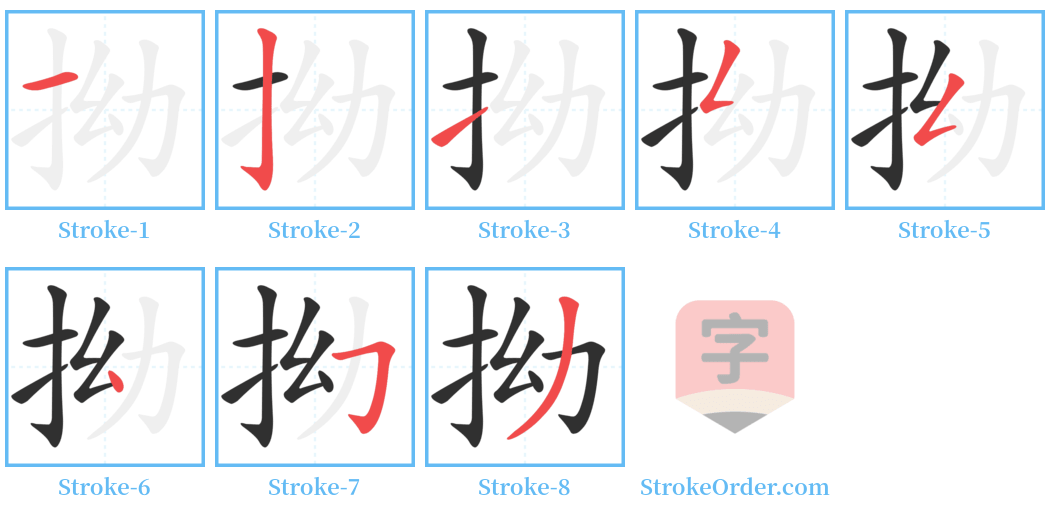拗 Stroke Order
Animated Stroke Order of 拗

Stroke Order Diagrams for 拗

Step-by-Step Handwriting Guide for 拗

Learn to Write Chinese Characters with Video Tutorials
Watch the video of writing the Chinese character "拗", learn the correct stroke order (笔顺) of the character "拗", and master the standard way of writing the character "拗".
Free Printable Handwriting Practice with Stroke Order: 拗
Printable Writing Practice Worksheet of "拗" in Portrait Orientation (Tian Zi Ge)

Printable Writing Practice Worksheet of "拗" in Landscape Orientation (Tian Zi Ge)

Information of 拗
Pinyin
niù、 ǎo、 ào
Radical
扌
Strokes
8 strokes
Usage
★★★★★
Definition
bend / break in two, stubborn / contrary
拗
抝 ǎo
〈动〉
1. Break; to bend until it breaks. (e.g. the bamboo pole broke.)
2. Turn; bend.
3. Also see ào; niù.
拗
抝 ǎo
〈动〉
1. Same as the original meaning (break).
Example: In "The Lotus Can't Be Separated," bending the lotus makes it impossible to break the thread.
Example: In "Medicine," carefully opened it, and white gas emerged from the burnt skin, dispersing into two halves of a white bun.
2. Turn; bend.
Example: He always smiles when reading this, tilting his head back, swaying, and bending backward.
3. Also see ào; niù.
拗
抝 ō
1. Disobedient; does not comply. (e.g. disobey orders.)
2. Hard to pronounce; not in accordance with the regular rhythm when writing ancient poetry.
3. Pry; open.
拗
抝 ō
〈动〉
1. Disobey; violate.
Example: No matter how hard the ancient heart lashes out, it's still hard to go against the world.
Example: As in "Stubborn and Recalcitrant," not complying; repressing anger; going against orders; being obstinate.
2. Hard to pronounce.
Example: Nothing is more complicated and difficult to remember than this.
3. Pry open.
Example: In "The Glutton," his mouth was like a corpse, hard as iron and stone to pry open.
拗
抝 niù
〈形〉
1. Stubborn; obstinate; pigheaded. (e.g. obstinate nature; strong-willed.)
Examples: Being contrary; not compliant; stubborn nature; strong resistance; as in strong personality traits symbolizing stubbornness.
拗
抝 niù
〈动〉
1. Turn back in the opposite or non-conforming direction.
Example: Such as turning the neck or bending; to twist.
2. Also see ào; ào.
拗
抝 niù
〈形〉
Stubborn; obstinate; pigheaded.
拗
抝 niù
〈动〉
1. Turn back.
Example: Such as twisting or turning.
2. Also see ào; ào.
(*Quoted from traditional dictionary explanations)
1. To restrain. Examples from historical texts indicate its various usages in context, showcasing acts of suppression or restraint.
Input Method for 拗
Pinyin
niu4
Wubi
rxln|rxet
Cangjie
qvis
Zhengma
dzzy
Four Corner
54027
Unicode
U+62d7
Same Pronunciation Characters